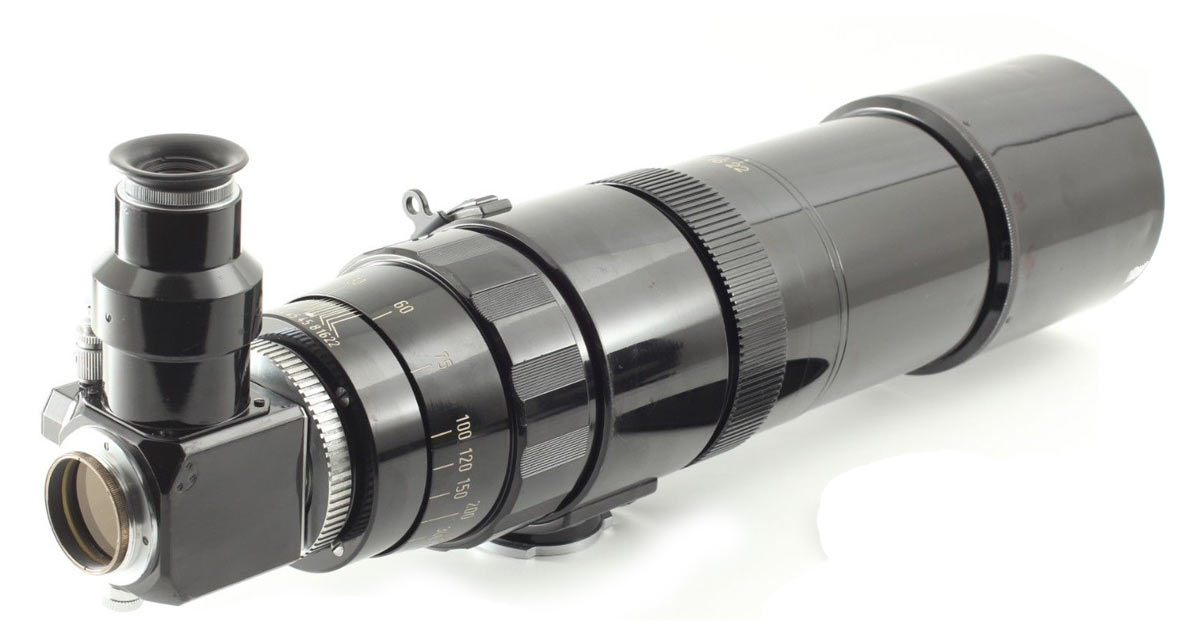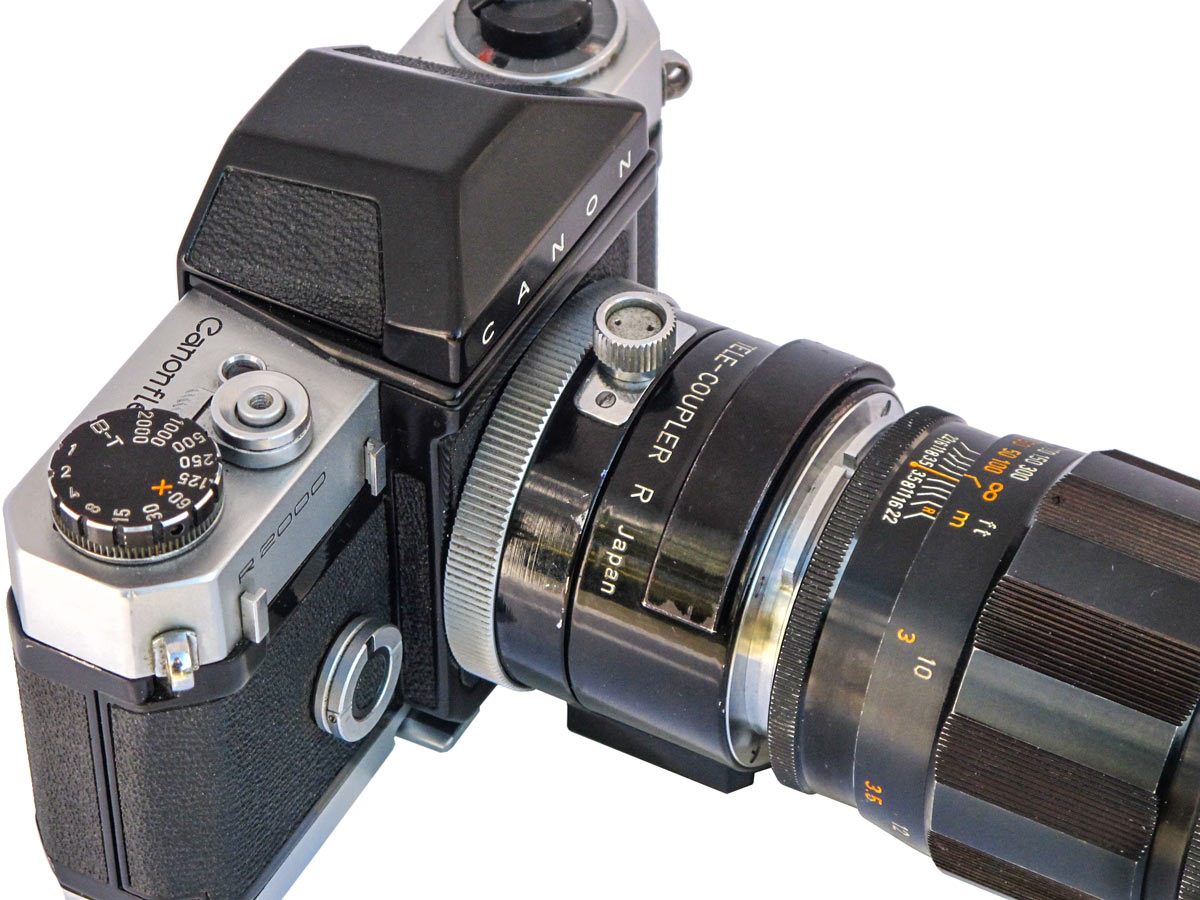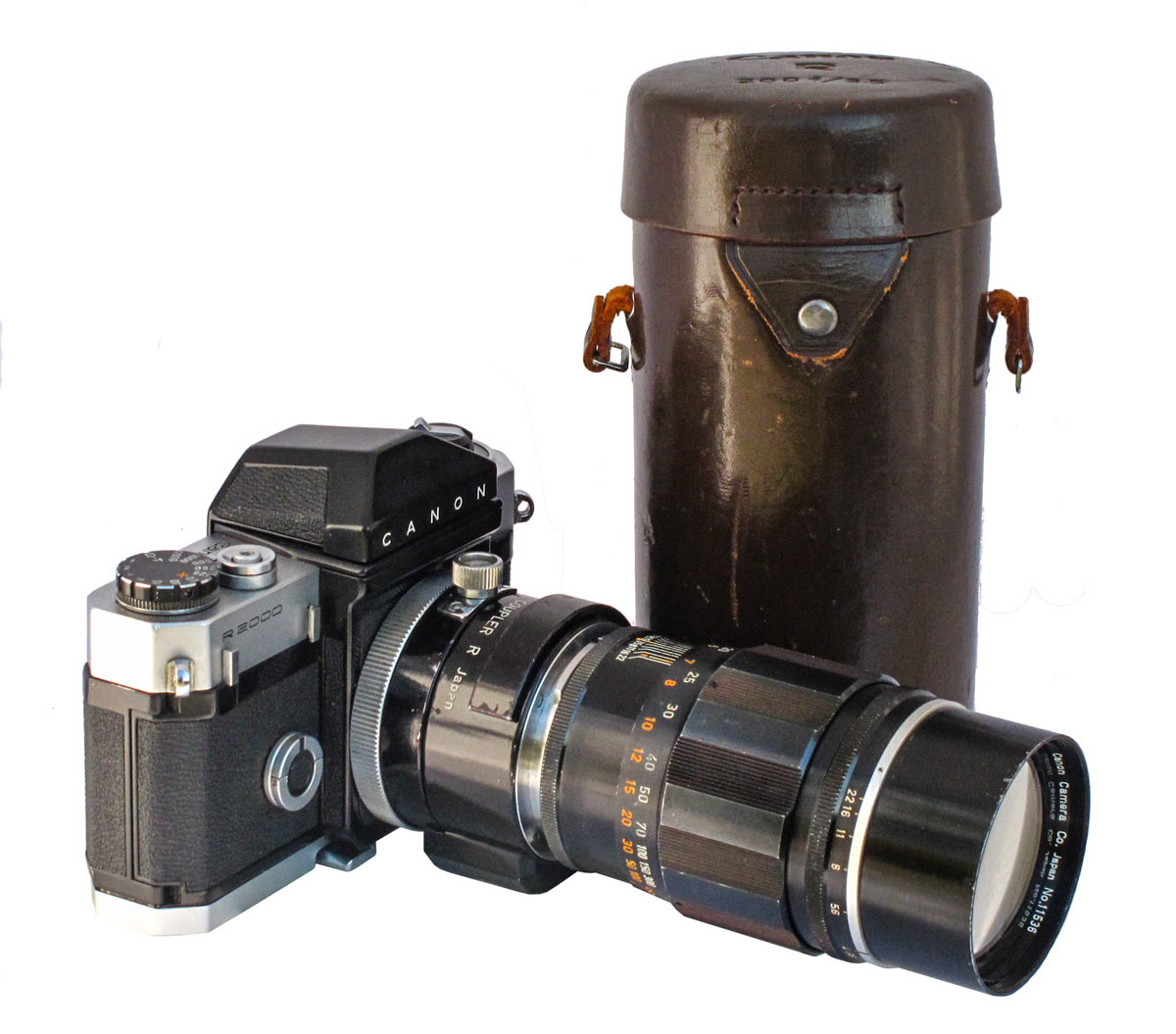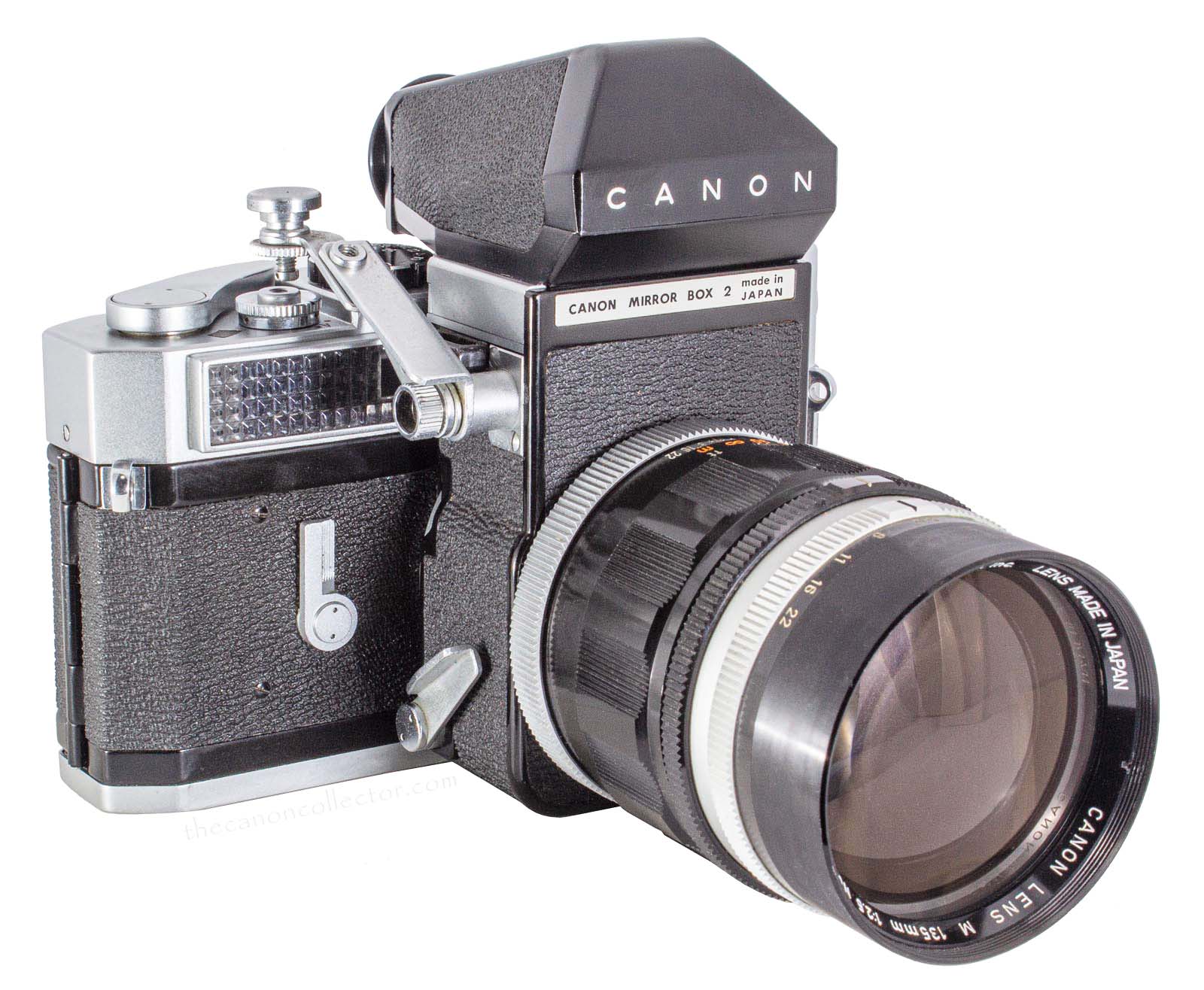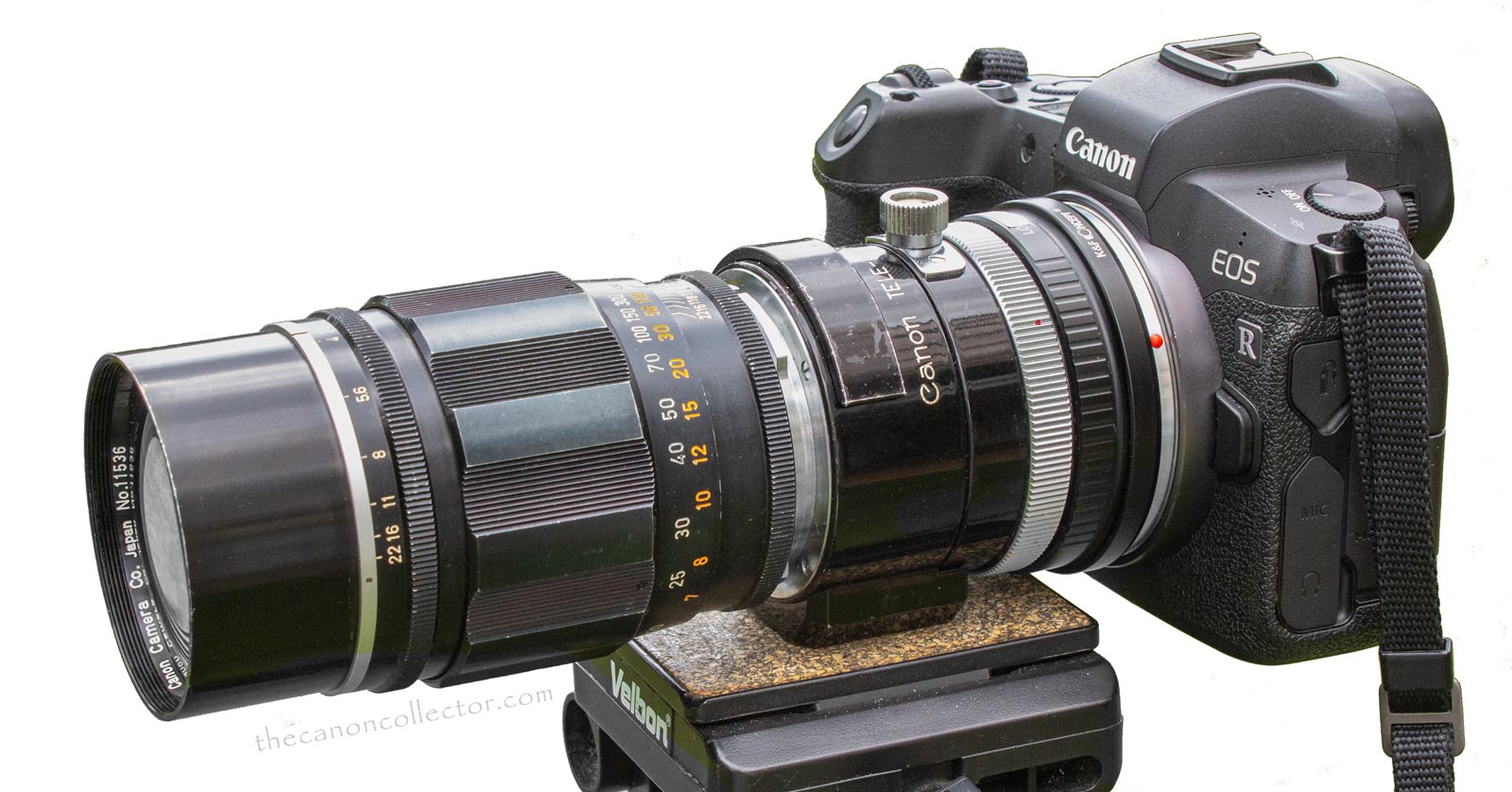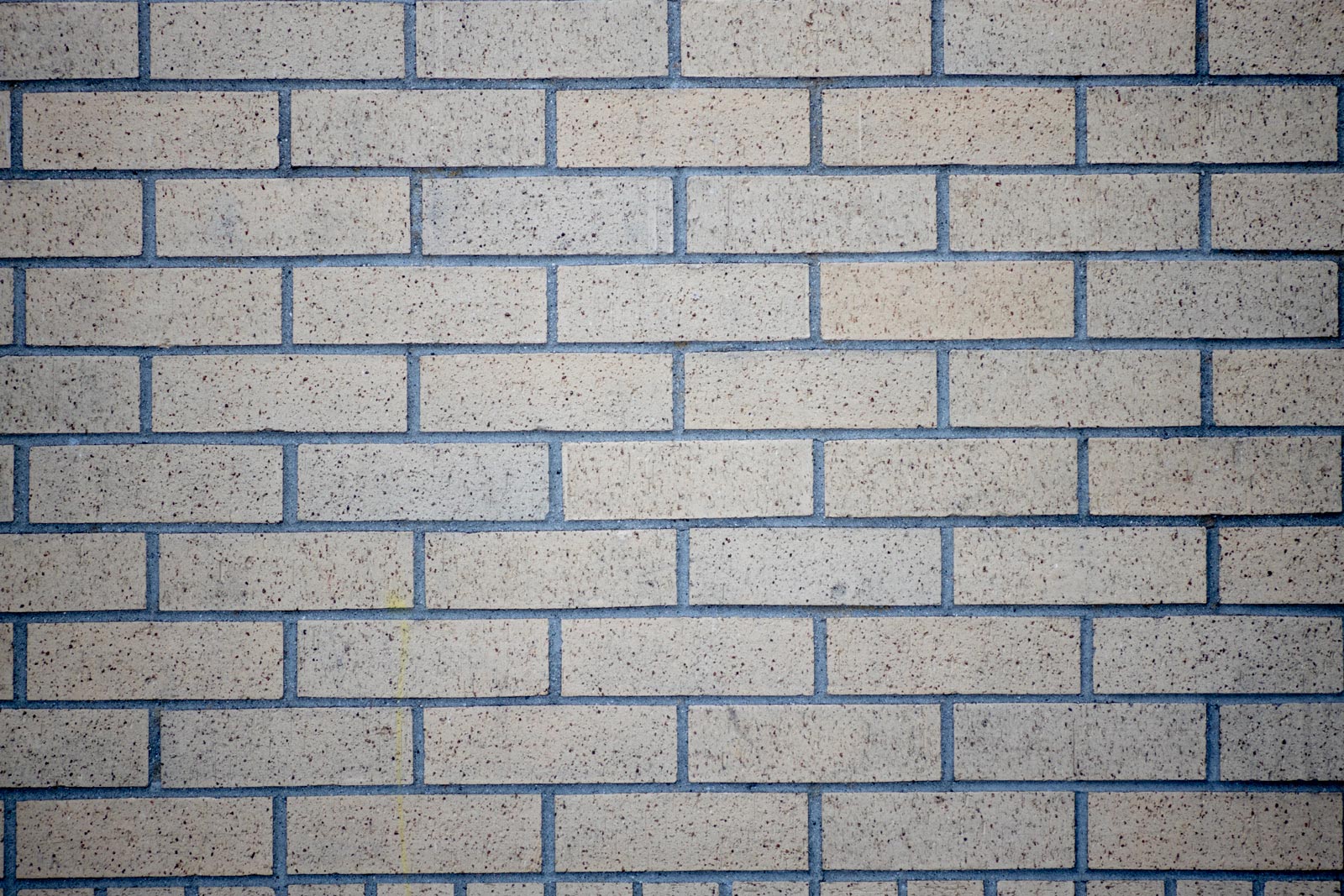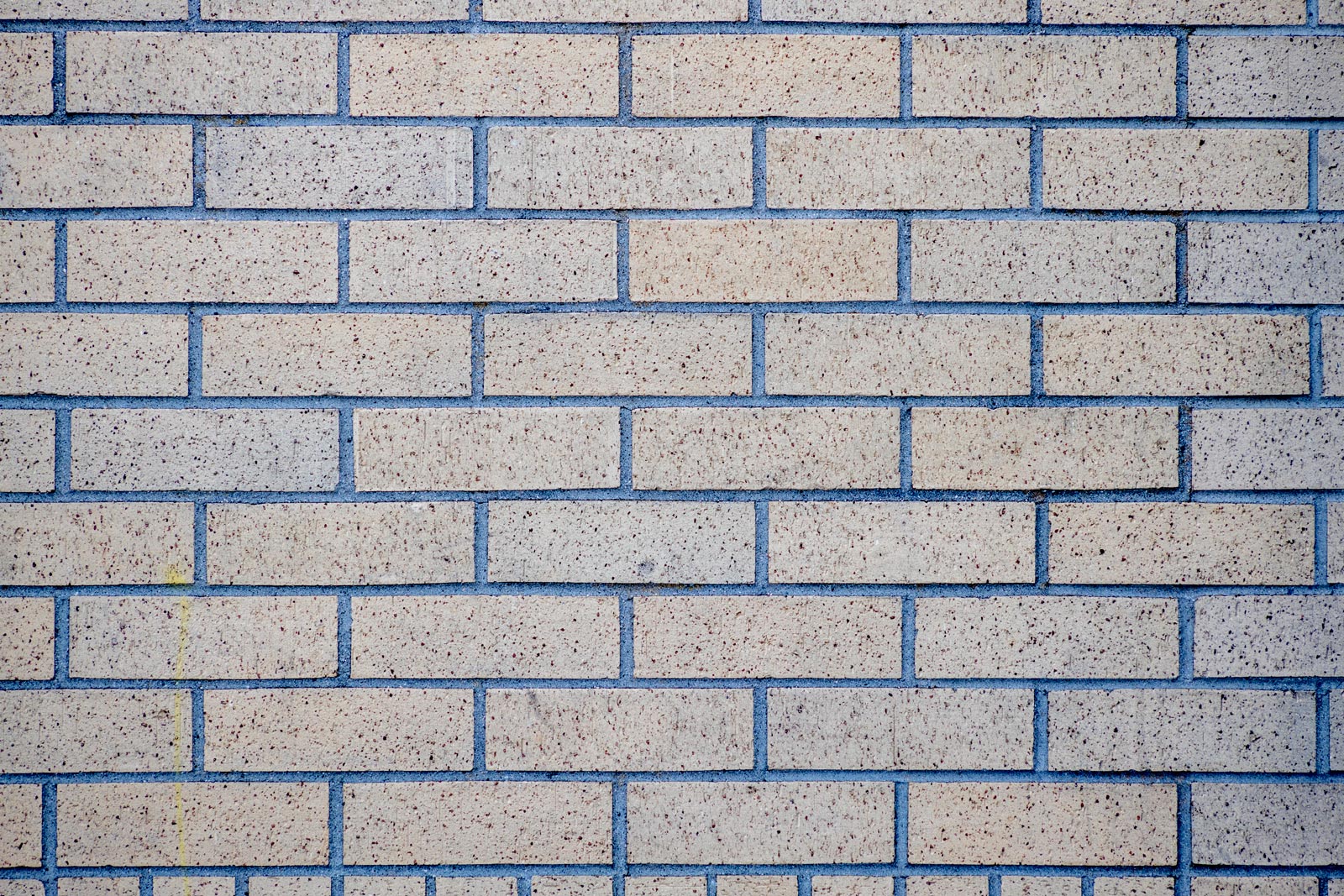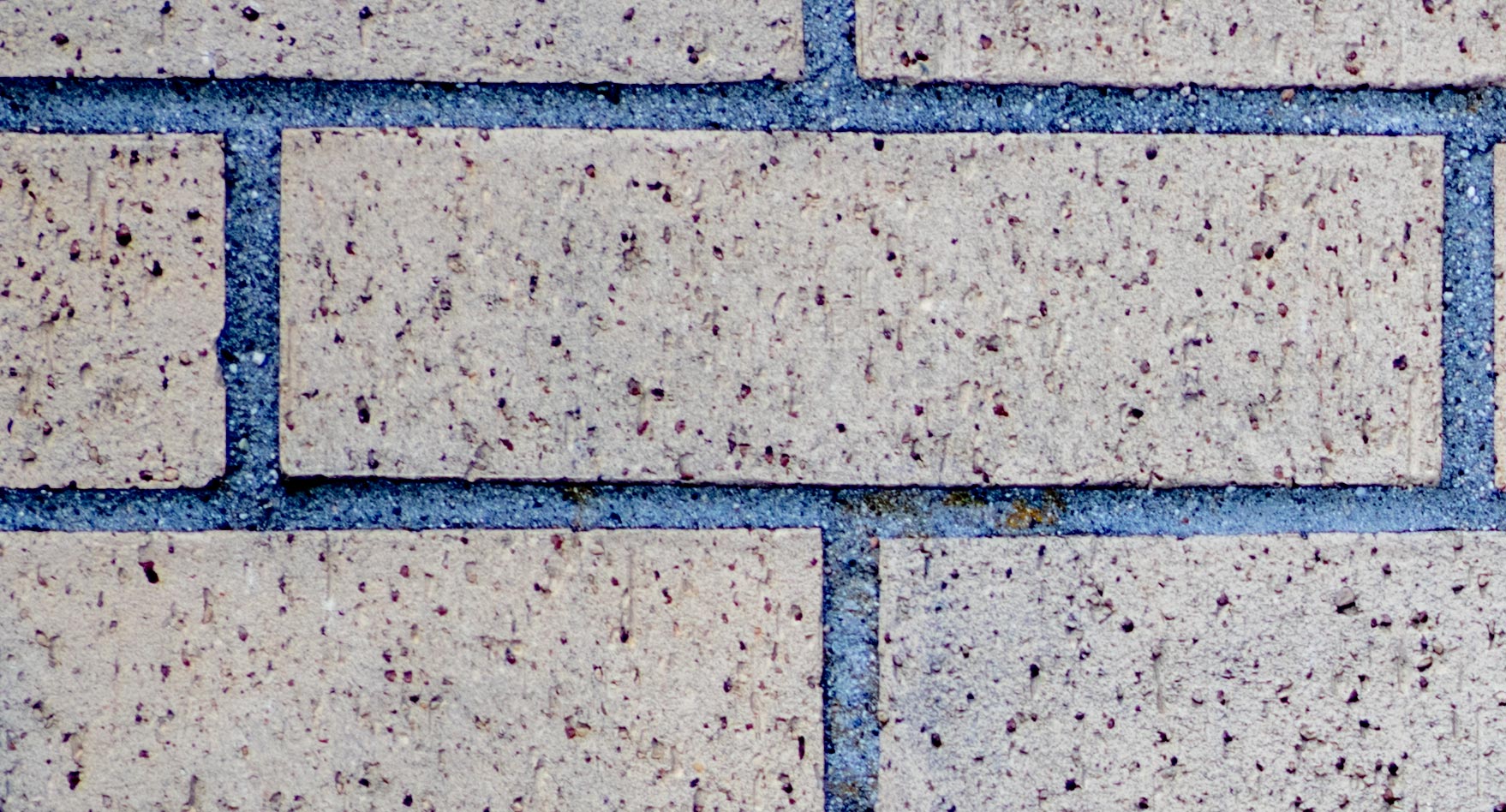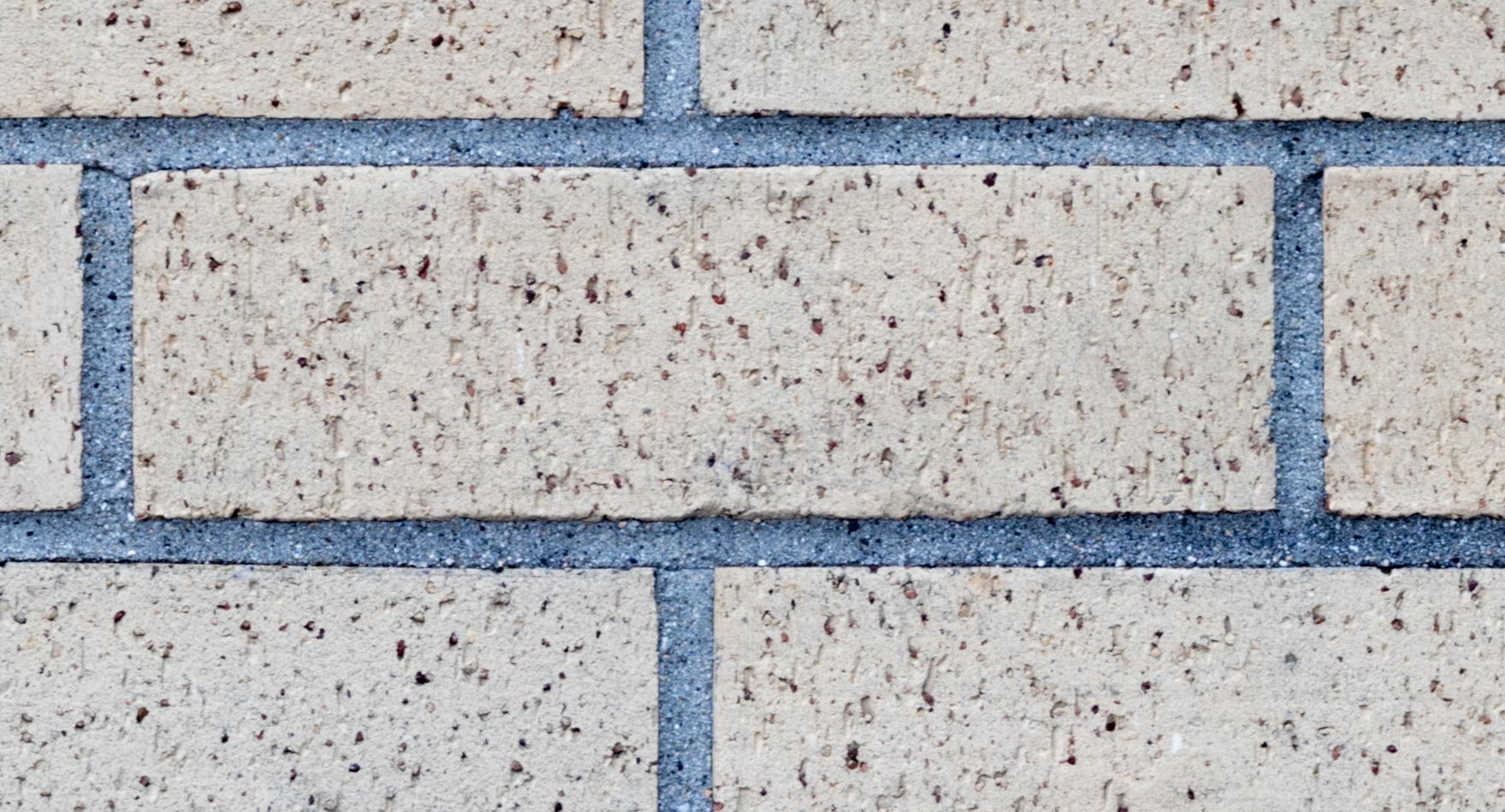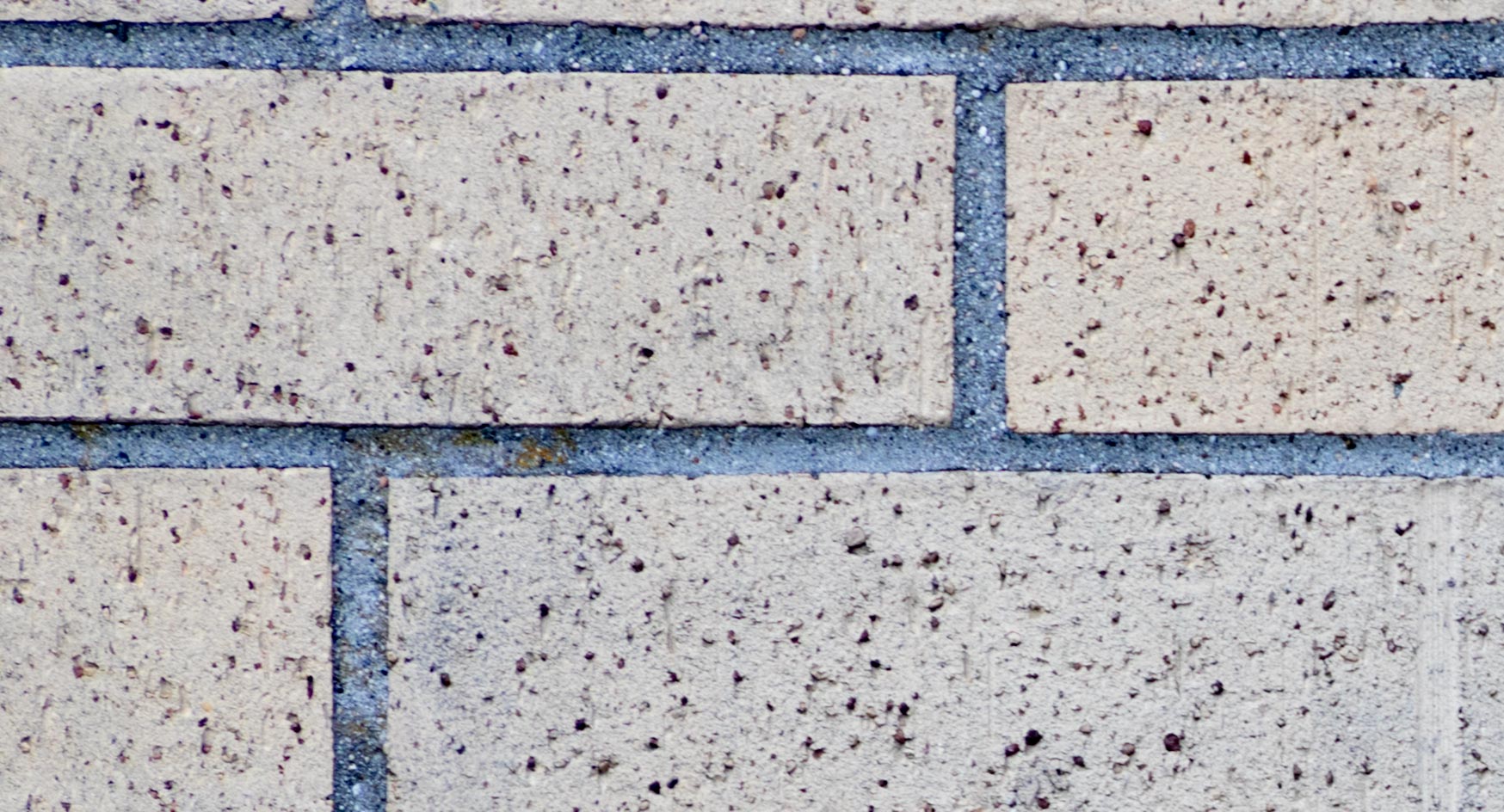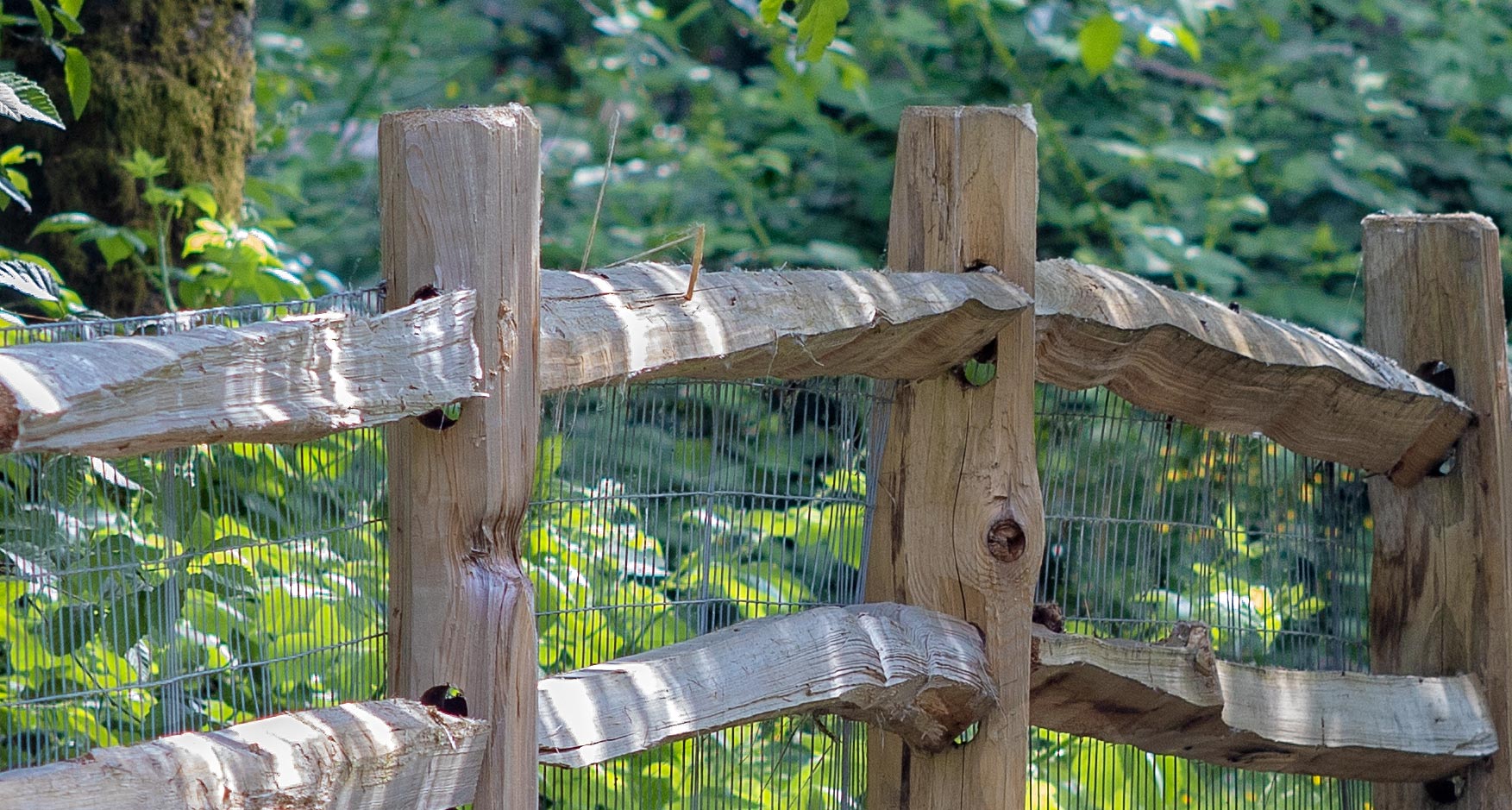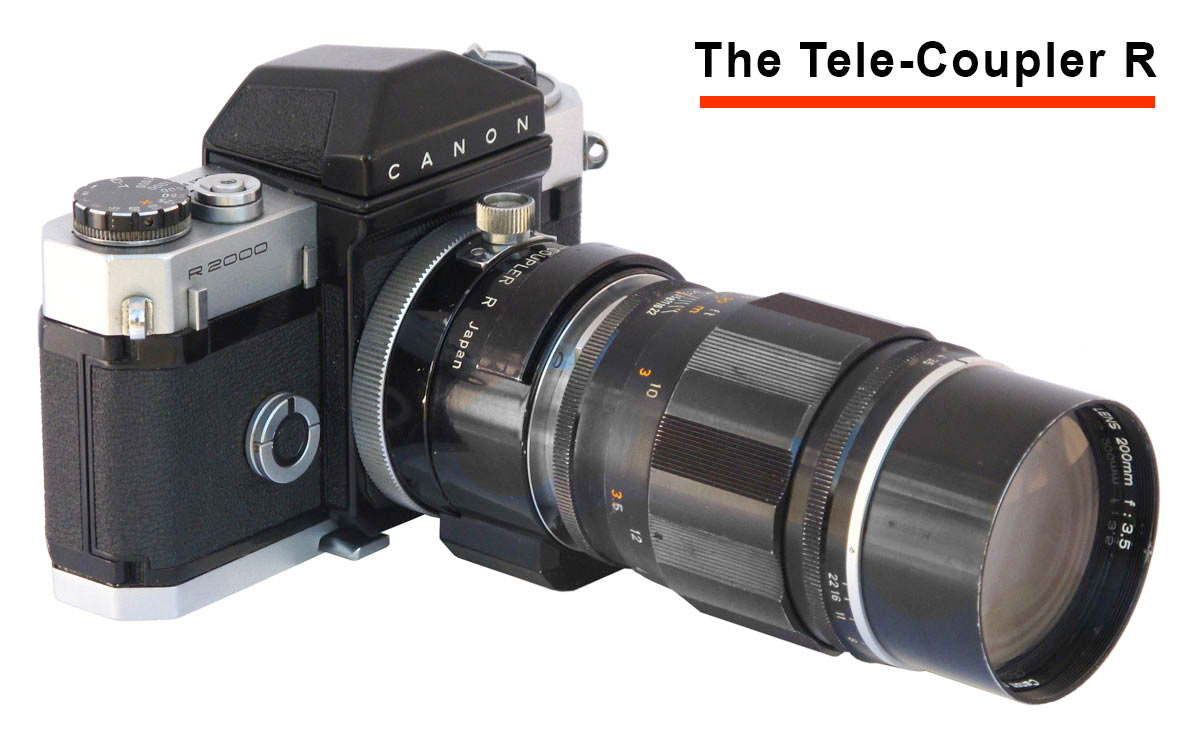
My Canonflex R2000 (Ser. No. 55992) has mounted
on it the Canon Tele-Coupler R with a 200mm f/3.5 lens attached. The Coupler inserts
the same thickness between lens and film as the Mirror Box 2 does for range finder cameras
allowing the M200mm f/3.5 to be mounted on one of the four Canonflex cameras. Actually, it works for any
of the R, FL or FD lens mounts but, of course, the lens will not function automatically at all.
This is the Mirror Box 1 fitted with a 400mm lens. The Mirror Box screws into the standard M39 lens mount of a rangefinder camera.
On page 9 of this 1954 Catalog there is a listing for the 800mm lens referred to in the text with the “mirror box housing”. On page 11 the Mirror Box is listed as being available separately.
I was browsing in a local camera store and I came across the above lens assembly. I didn’t know what it was other than the lens said “Canon Lens 200mm f:3.5” and it had an M39 screw mount. The attachment said “Tele-Coupler R” and the lens was screwed into it. The lens mount had a two lug bayonet mount ring which I didn’t recognize. It was a new one to me. The lens and converter were fitted into a brown leather camera case that said “Canon R 200 f/3.5”.
The clerk in the camera store was equally perplexed and so we bargained a price with neither of us really knowing the value of the item we were negotiating
Once home with my new treasure I found it mounted easily on my Canonflex R2000 and focused to infinity correctly. But what did I have?
The internet was very confusing on the subject. I found the Tele-Coupler R easily enough but there seemed to be no clear explanation for it. So I continued to dig and I think I finally understand this family of attachments. Let me explain what I found.
Rangefinder cameras have trouble focusing beyond thirty or forty feet because as the distance from the camera increases the angle being measured becomes small and tolerances critical. But long lenses, anything beyond about 200mm, are very sensitive to focus at those ranges. For this reason Canon made no 200mm lenses for their rangefinder cameras that relied on the rangefinders.
We have a Newsletter
There is a Newsletter for thecanoncollector.com to keep you up to date on what we are posting. Try it!
Canon did introduce an 800mm f/8.0 lens in March of 1953 (Kitchingman). They solved the focus problem by mounting it on what they called a “mirror box housing” or “mirror reflex housing”. This later came to be called the Mirror Box 1 and this is how I shall refer to them hereafter. A mirror was inserted into the light path which diverted the light up to a ground glass with a view finder lens above it. When the picture was taken the mirror was first moved up out of the way and the shutter could then be released. Not a very satisfactory arrangement. Although this Mirror Box was of Canon’s usual solid build, it was awkward to use and certainly not useful for sports or action photography.
According to Kitchingman Canon released a 200mm f/3.5 lens in March of 1957 and a 600mm f/5.6 and 400mm f/4.5 in August of 1958 all of which required the Mirror Box 1.
Canon introduced the Model P in December of 1958. In the advertising brochure promoting this camera a 200mm f/3.5 and 400mm f/4.5 lenses are shown with the Mirror Box 1.
So, up to the introduction of the Model P the Mirror Box 1 was the solution for focusing long focus lenses.
This changed with the introduction of the Canonflex camera in May of 1959. With the addition of the mirror in the camera the Mirror Box 1 was no longer required. Now long focus lenses could be focused by the camera in real time and very much more conveniently.
However, to go with the new camera Canon needed lenses and it was far easier to adapt existing lenses to the new camera than to create new ones from scratch. This is where the Tele-Coupler R came in.
The Mirror Box 1 added space between the lens and the film plane in the rangefinder camera and the long lenses that used the Mirror Box 1 could not mount directly on the Canonflex. However, the Tele-Coupler R added sufficient space for these lenses to function on the Canonflex properly with accurate infinity focus.
This is a closeup of my Canonflex R2000 with the Tele-Coupler R and 200mm lens mounted. You can see that my Tele-Coupler R is a little worn around the edges.
This is the top of the Tele-Coupler R. It has the chrome ring of the new “R” mount introduced with the Canonflex. The knurled knob when loosened allowed the whole mount to rotate by 90 degrees to change picture orientation.
The Tele-Coupler R has a built in filter mount which is shown removed from the Coupler. This mount has a 39mm thread cut into it.
So that is my Tele-Coupler R. A little bit beaten up but a welcome addition to the Collection. However, let’s take a minute to finish the “Coupler” story.
In January of 1961 Canon introduced the Model 7 and the Mirror Box 2. Now remember, at this point the last camera in the Canon lineup was the Canonflex and the Model P before that.
It is interesting to note that in late 1961 Canon introduced two lenses designed especially for the Mirror Box 2. They were the M 200mm f/3.5 and the M 135mm f/2.5. They were the only two lenses to be designated as “M” series lenses until the EOS-M cameras of our day. I have tried to fit Canonflex R lenses and lenses for the Tele-Coupler onto the Mirror Box 2 but they don’t fit. Well, they fit but they won’t focus. If you look in the User Manual for the Model 7 the only lenses listed for the MB2 are the two M lenses referred to here.
But think about the confusion at that time. A couple of years after the introduction of the Canonflex Canon was still developing range finder cameras. SLR cameras were new and had not taken a large share of the market up to that point. Canon did not show dedication to the new system until introduction of the F series of cameras with the Canon FX later in 1964. All of the camera companies were cautious because to misjudge the market could spell the end of a company.
The details of my own copy of the Tele-Coupler R are:
Released: 1958
Serial No: none apparent
Lens Mount: on the camera side a Canon R mount (for the Canonflex camera) and on the lens side an M-39 thread.
Condition: Condition is very good but there are signs of hard use although the unit is sound.
Acquisition: The Lens and Tele-Coupler were acquired October 10, 2018. The photographs here of the Coupler are the unit I have.
This is the Mirror Box 2 mounted on
a Canon Model 7. The Mirror Box 2 was
created for two long focus lenses, the M 135mm,
shown on the camera, and the M 200mm.
The top lever on the side of the Mirror Box 2 extended over the shutter button and when it was depressed to fire the camera the mirror first flipped up out of the way. The mirror stayed in the up position until reset with the lower lever.
So how does it shoot?
I don’t really understand this enjoyment of using these old cameras and lenses but I do find it to be fun. And besides being fun I do learn a great deal in actually trying these things out. Look
at this image of my Tele-Coupler R mounted on my
Canon R digital camera. I have used my FD to RF
converter which shows that the Tele-Coupler can
be used on any FD mount camera.
The lens is the 200m one made specifically for the
Tele-Coupler. This is a manual lens with no provision
for auto-diaphragm operation. This is a problem
because the front of the lens rotates with focusing. But
the f/stop ring is on the front portion of the lens so it rotates
with focusing. This means that if you focus wide open, as you should, and then you set the f/stop you risk changing the focus. But if you set the f/stop first then you are trying to focus with less light in the viewfinder and the depth of field is deeper which makes accurate focus more difficult.
Being aware of that failing, the lens works like any other 200mm lens of the time. There is no image stabilization which is a problem and, as you know, the Canon R does not have ‘in body image stabilization’. Without stabilization, hand holding a 200mm lens is a challenge but it can be done with high shutter speeds. So, off to the brick wall!
Below are images taken at f/3.5, 5.6 and 8.0. Forgive the colors as the day was cloudy. The full frame image is on the left, the center at 100% is in the center and on the right are images of the upper left corner at 100%. All are hand held which was a mistake. I should have used a tripod. However, the shutter speeds were all 250th and higher.
What we can see is that the lens has a modest vignette which is largely cleared up by f/5.6. The center of each image is reasonably sharp but not what I would call crisp. I have applied no sharpening or post processing. However, considering that the lens was designed for use with film, it is probably acceptable for that medium.
The corners tell another tale. At f/3.5 the extreme corners are not great. Besides the vignette sharpness falls off in the corner. This gets better at f/5.6 and by f/8 it compares favorably with the center of the image.
f/Stop
Full Frame
Center at 100%
Upper Left Corner at 100%
All of the above is fine as far as it goes but these faults do not have to stand in the way of a good photograph. You just have to know where and how to use it. It is not a low light lens, and it should be used stopped down to at least 5.6. So, this lens is for use in good light, stopped down, with a shutter speed of at least 1/250th.
The fence in this picture runs at 45 degrees to the film plane and so it is not all in focus. On the left are the 4th, 5th and 6th fence posts from the left which are in reasonable focus. They are enlarged to 100% and the image has had some basic sharpening.
The lens was set to f/8 and shutter speed was 1/500th so the lens had every chance to perform and it did reasonably well.
It is not up to today’s standard for such lenses but for a film camera of the 1960’s it is a good lens.
This website is the work of R. Flynn Marr who is solely responsible for its contents which are subject to his claim of copyright. User Manuals, Brochures and Advertising Materials of Canon and other manufacturers available on this site are subject to the copyright claims and are the property of Canon and other manufacturers and they are offered here for personal use only.

